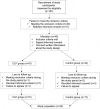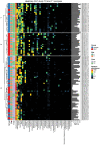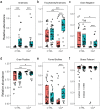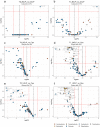Orofacial clefts alter early life oral microbiome maturation towards higher levels of potentially pathogenic species: A prospective observational study
- PMID: 36632344
- PMCID: PMC9828641
- DOI: 10.1080/20002297.2022.2164147
Orofacial clefts alter early life oral microbiome maturation towards higher levels of potentially pathogenic species: A prospective observational study
Abstract
Orofacial clefts (OFC) present different phenotypes with a postnatal challenge for oral microbiota development. In order to investigate the impact of OFC on oral microbiota, smear samples from 15 neonates with OFC and 17 neonates without OFC were collected from two oral niches (tongue, cheek) at two time points, i.e. after birth (T0: Ø3d OFC group; Ø2d control group) and 4-5 weeks later (T1: Ø32d OFC group; Ø31d control group). Subsequently, the samples were analyzed using next-generation sequencing. We detected a significant increase of alpha diversity and anaerobic and Gram-negative species from T0 to T1 in both groups. Further, we found that at T1 OFC neonates presented a significantly lower alpha diversity (lowest values for high cleft severity) and significantly higher levels of Enterobacteriaceae (Citrobacter, Enterobacter, Escherichia-Shigella, Klebsiella), Enterococcus, Bifidobacterium, Corynebacterium, Lactocaseibacillus, Staphylococcus, Acinetobacter and Lawsonella compared to controls. Notably, neonates with unilateral and bilateral cleft lip and palate (UCLP/BCLP) presented similarities in beta diversity and a mixture with skin microbiota. However, significant differences were seen in neonates with cleft palate only compared to UCLP/BCLP with higher levels of anaerobic species. Our findings revealed an influence of OFC as well as cleft phenotype and severity on postnatal oral microbiota maturation.
Keywords: Orofacial clefts; early life dysbiosis; microbiome maturation; neonates; oral microbiome.
© 2023 The Author(s). Published by Informa UK Limited, trading as Taylor & Francis Group.
Conflict of interest statement
No potential conflict of interest was reported by the authors.
Figures








Similar articles
-
Orofacial clefts lead to increased pro-inflammatory cytokine levels on neonatal oral mucosa.Front Immunol. 2022 Nov 16;13:1044249. doi: 10.3389/fimmu.2022.1044249. eCollection 2022. Front Immunol. 2022. PMID: 36466891 Free PMC article.
-
Palatal growth changes in newborns with unilateral and bilateral cleft lip and palate from birth until 12 months after early neonatal cheiloplasty using morphometric assessment.Clin Oral Investig. 2021 Jun;25(6):3809-3821. doi: 10.1007/s00784-020-03711-9. Epub 2021 Jan 6. Clin Oral Investig. 2021. PMID: 33409695
-
Three-dimensional development of the palate in bilateral orofacial cleft newborns 1 year after early neonatal cheiloplasty: Classic and geometric morphometric evaluation.J Craniomaxillofac Surg. 2020 Apr;48(4):383-390. doi: 10.1016/j.jcms.2020.02.019. Epub 2020 Mar 3. J Craniomaxillofac Surg. 2020. PMID: 32184075
-
The evolution of human genetic studies of cleft lip and cleft palate.Annu Rev Genomics Hum Genet. 2012;13:263-83. doi: 10.1146/annurev-genom-090711-163729. Epub 2012 Jun 6. Annu Rev Genomics Hum Genet. 2012. PMID: 22703175 Free PMC article. Review.
-
Burden of Orofacial Clefting in India, 2016: A Global Burden of Disease Approach.Ann Maxillofac Surg. 2018 Jan-Jun;8(1):91-100. doi: 10.4103/ams.ams_196_17. Ann Maxillofac Surg. 2018. PMID: 29963432 Free PMC article. Review.
Cited by
-
Oral Microbiome as a Tool of Systemic Disease on Cleft Patients: A New Landscape.Cureus. 2023 Feb 25;15(2):e35444. doi: 10.7759/cureus.35444. eCollection 2023 Feb. Cureus. 2023. PMID: 36994247 Free PMC article. Review.
-
Microbiome and Communication Disorders: A Tutorial for Clinicians.J Speech Lang Hear Res. 2025 Jan 2;68(1):148-163. doi: 10.1044/2024_JSLHR-24-00436. Epub 2024 Nov 21. J Speech Lang Hear Res. 2025. PMID: 39572259 Free PMC article. Review.
-
Investigating oral microbiome profiles in patients with cleft lip and palate compared with the healthy control.BMC Oral Health. 2024 May 28;24(1):623. doi: 10.1186/s12903-024-04387-3. BMC Oral Health. 2024. PMID: 38807164 Free PMC article.
References
-
- Mangold E, Kreiß M, Nöthen MM.. Syndromale und nichtsyndromale orofaziale Spalten. medizinische genetik. 2017;29(4):397–21.
-
- Allori AC, Mulliken JB, Meara JG, et al. Classification of Cleft Lip/Palate: then and Now. Cleft Palate Craniofac J. 2017;54:175–188. - PubMed
-
- Voigt A, Radlanski RJ, Sarioglu N, et al. Cleft lip and palate. Pathologe. 2017;38:241–247. - PubMed
-
- Kriens O In What is a cleft lip and palate? Proceedings of an Advanced Workshop, Bremen 1987. ed Kriens O editor; 1989.
LinkOut - more resources
Full Text Sources
